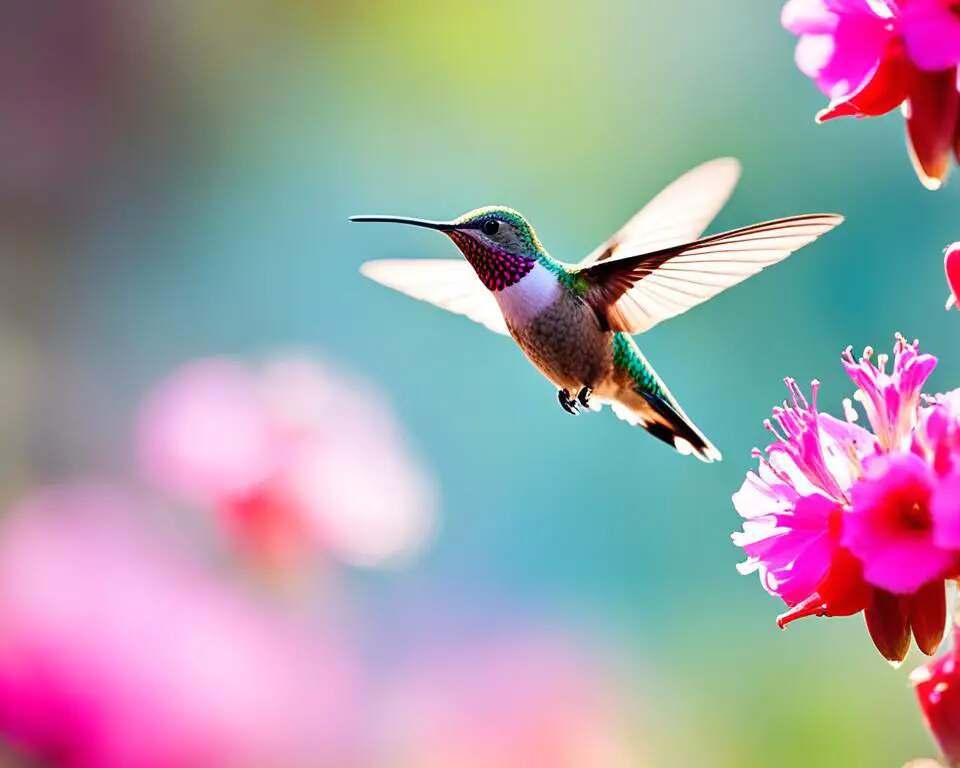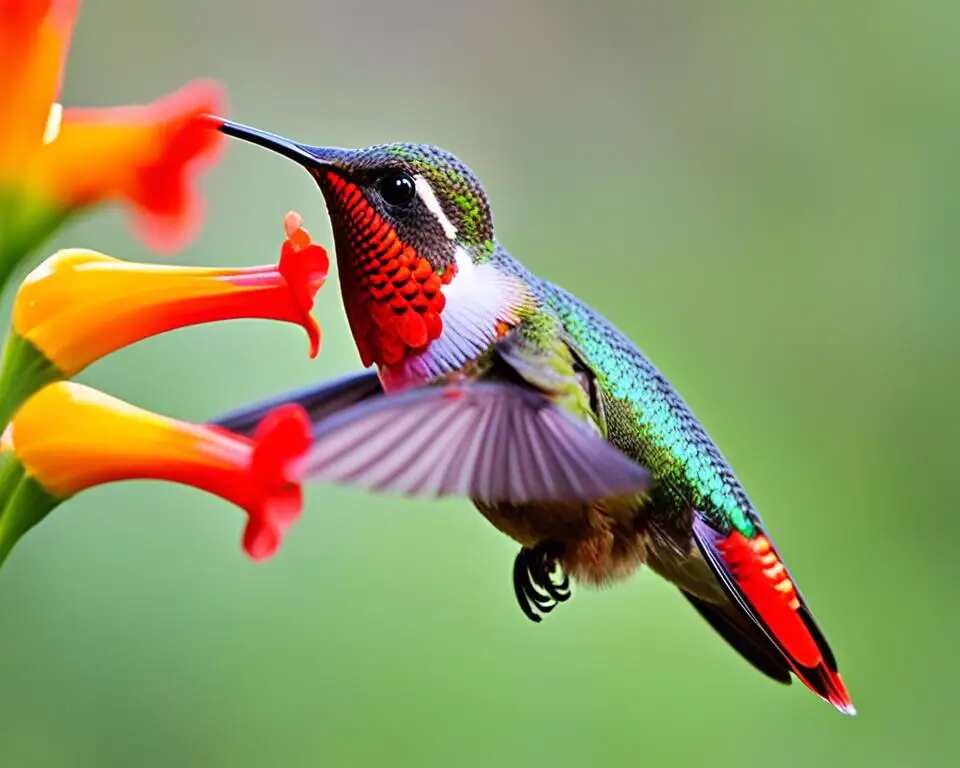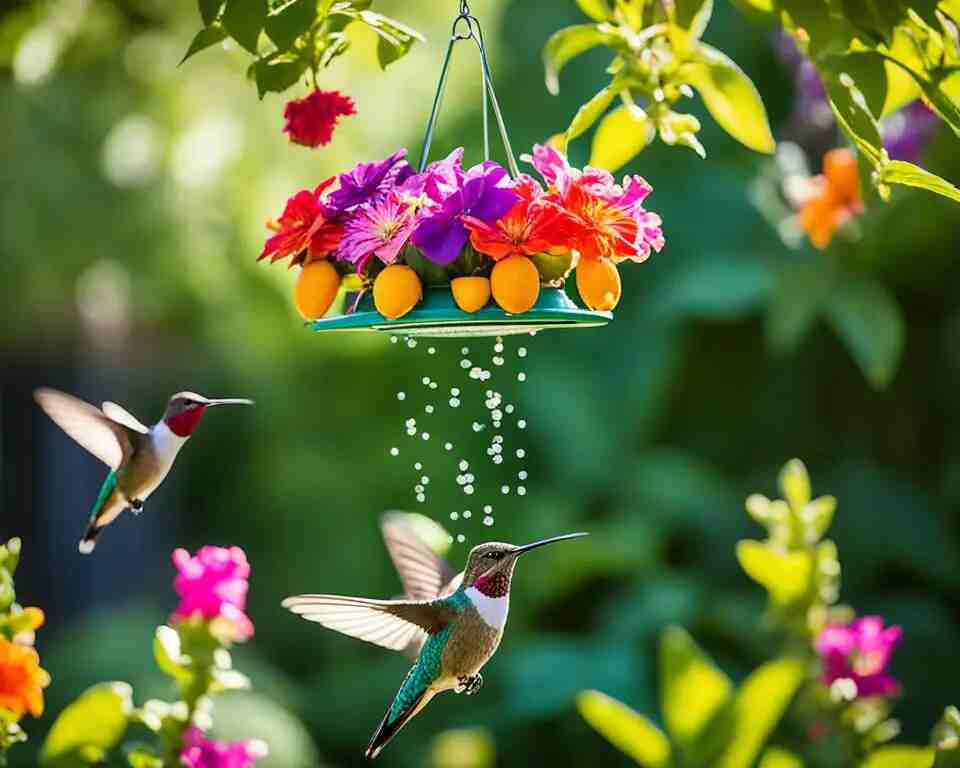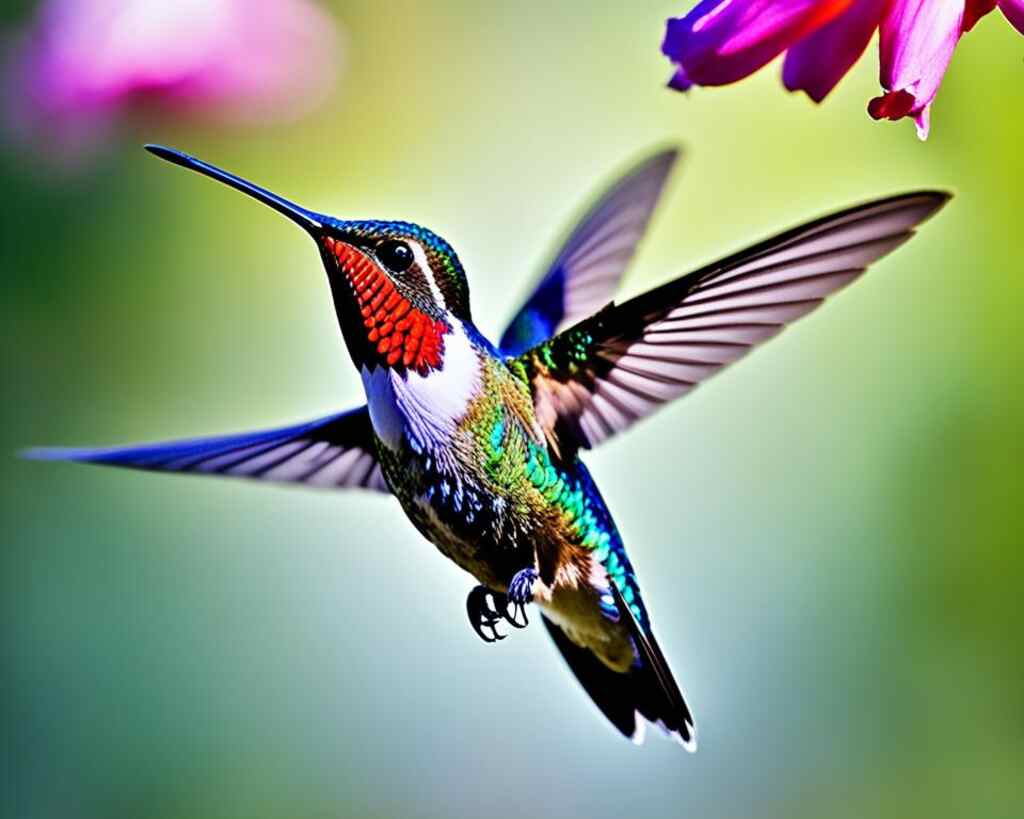Ever pondered what fuels hummingbirds’ remarkable energy and swift wing movements? These small, vivid birds thrive on a specialized diet. It propels their rapid metabolism and enables their elegant, swift flight.
To maintain their energy, hummingbirds consume nectar and insects. Nectar, a sugary fluid from flowers, supplies vital energy. But, can nectar alone sustain their dynamic lifestyle? And which insects provide the necessary proteins and nutrients?
This piece explores the hummingbird’s diet, highlights their preferred foods, and offers advice for drawing them to your garden. If you’re interested in bird watching or these intriguing animals, join me. Together, we’ll learn what hummingbirds eat and the best ways to feed them.
Table of Contents
Key Takeaways:
- Hummingbirds primarily feed on nectar from flowers, which provides them with essential sugars for energy.
- In addition to nectar, hummingbirds supplement their diet with insects and spiders, which offer protein and other nutrients.
- Providing a diverse range of nectar-rich flowers and offering sugar water in feeders can attract hummingbirds to your garden.
- Understanding the dietary needs of hummingbirds and offering suitable food sources can contribute to their health and well-being in your environment.

What Do Hummingbirds Eat
Hummingbirds primarily feed on nectar from flowers and sugar water. This nectar is a sweet substance that flowers produce, rich in sugars. It fuels hummingbirds’ high-energy lifestyle. To meet their protein needs, they also consume small insects like gnats, flies, spiders, and mosquitoes.
These birds eat both nectar and insects to keep their diet balanced. The nectar’s high sugar content powers their fast wing movements. Insects, on the other hand, provide essential protein and nutrients.
Their diet is crucial for their health. By offering various food sources, we can ensure they get all needed nutrients. Providing a mix of nectar-rich flowers and sugar water attracts these lively birds to our yards.
The Intricate Diet of Hummingbirds
Hummingbirds boast a complex diet crucial for their survival. It includes nectar, insects, and spiders, tailored to their high-energy lifestyle. Each element of their diet is essential, supporting their rapid metabolism.
Nectar: A High-Energy Requirement
Nectar fuels hummingbirds with essential sugars. They have evolved bills and tongues specifically for extracting nectar. This sugary fluid powers their dynamic flight and quick wing movements. It’s pivotal for their ability to hover and zip between flowers in search of food.
Proteins and Insects: The Need for Nutrients Beyond Sugar
Hummingbirds need more than just sugar for optimal health. They feast on insects and spiders for protein and vital nutrients. These protein sources are indispensable for growth, reproduction, and overall wellness. With precise movements, they capture their prey mid-flight.
Digestive Wonders: How Hummingbirds Process Their Sugary Diet
Their digestive system is adapted to efficiently handle a sugar-rich diet. Powerful enzymes and muscles breakdown sugar rapidly, avoiding fat buildup or high blood sugar. This efficiency ensures hummingbirds maximize nutrient absorption, thriving on their specialized diet.

| Food Type | Role |
|---|---|
| Nectar | Provides high-energy sugars for fuel |
| Insects | Supply crucial protein and nutrients |
| Spiders | Offer additional protein and micronutrients |
Hummingbirds’ Diverse Menu: From Flowers to Feeder Solutions
Hummingbirds feast on nectar from a selection of flowers and homemade sugar water solutions. Flowers like bee balms, columbines, and lilies are their top picks due to high nectar. Adding these nectar-rich plants in your garden can invite hummingbirds naturally.
To complement flowers, offer homemade sugar water solutions. This simple mix mirrors nectar’s sweetness, enticing hummingbirds. For this, mix one part sugar with four parts water. Boil to dissolve the sugar then let it cool before use in feeders.
It’s crucial to feed hummingbirds safely. Avoid food coloring or additives in homemade nectar; they can harm. A clean mix of sugar and water is safe and nutritious for them.
Cleanliness counts when using feeders or offering nectar from flowers. Wash and refill feeders regularly, every few days, to avoid harmful mold or bacteria. This keeps the nectar fresh and safe, ensuring hummingbirds stay healthy.
To entice hummingbirds, provide varied food sources, including both natural and homemade options. Catering to their preferences and practicing safe feeding can attract hummingbirds. Thus, you can offer them the sustenance they seek.

Seasonal Feeding Habits: Adapting to the Environment
Hummingbirds’ feeding habits shift with the seasons, depending on nectar availability. Grasping these changes enhances your ability to support them year-round.
Seeking Nectar Sources: Hummingbirds in Bloom Season
In bloom season, hummingbirds seek nectar from flowers and feeders. The plethora of flowers fulfills their energy demands. They favor brightly colored, tubular flowers for easy nectar access. Planting various nectar-rich flowers encourages these birds to feast and flourish in your garden.
Winter Diets: Survival Without Flowers
Without blooms in winter, hummingbirds adapt their diet for survival. Lacking natural nectar, they turn to insects for energy and nutrients. They might also feed on tree sap from woodpecker wells. Offering protein like mealworms or fruit flies aids their winter sustenance when options dwindle.
Feeding Hummingbirds Throughout the Year
Year-round support for hummingbirds involves consistent feeding. Dissolve one part white granulated sugar in four parts water for feeder supplement. Change the sugar water every 3-5 days to avert spoilage and health risks to hummingbirds. Clean feeders regularly to provide these vibrant birds with safe and accessible food, encouraging them to thrive in your yard through all seasons.
Conclusion
Offering the right food is key to attracting hummingbirds. By providing nectar and sugar water, you make your yard appealing to these birds. A diverse and safe environment is crucial. This invites hummingbirds to visit and stay.
Hummingbirds should be fed throughout the year. Maintenance of their feeders is also important. This ensures they consistently have access to food, even when flowers are scarce. Clean feeders with fresh nectar keep them returning.
Experience the enchantment of hummingbirds right in your own backyard. Whether you choose to invest in high-quality feeders or craft DIY hummingbird feeders with your children, you can effortlessly draw these captivating creatures closer to home. By providing attentive care, transform your yard into a cherished sanctuary they’ll love to visit.



